NETTING
The cage net is the most valuable component in any fish cage system. Cage nets are ingeniously constructed and include many different features for safe and practical deployment. All nets should be manufactured to the highest possible quality and should be thoroughly inspected after each process and right up to the complete finish of the process.
Net characteristics and cage design can make the difference between a successful fish farm and a failure. Net design, details, specifications and characteristics must be tailored to each farm.
Having highly reliable net cages is essential.
This requires attention to several factors, such
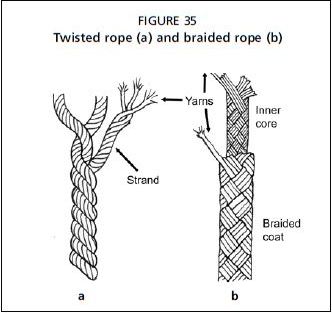
TABLE 21
Weight and breaking load for a three-strand polysteel rope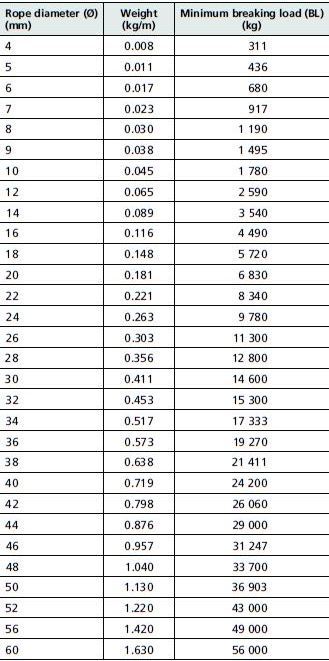
TABLE 22
Weight and breaking load for a polyester hightenacity twisted rope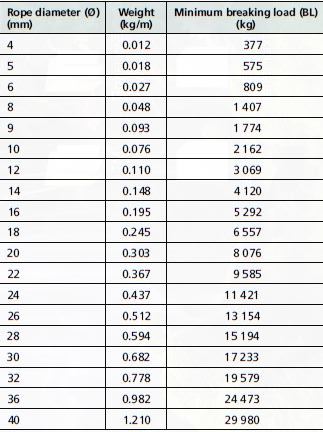
TABLE 23
Weight and breaking load for a polyamide (PA) or nylon rope
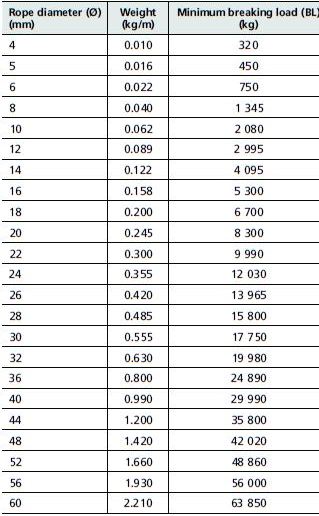
as net cage design, manufacturing, strength of netting and net components, strength loss in use, handling and storing.
Net characteristics material, size, shape and thickness
Netting can be produced as either knotted or knotless. Nylon knotted netting was widely used in the early stages of cage aquaculture because knotted nets were traditionally used in the fishing industry. Knotted nets have good resistance to wear and are relatively easy to repair. However, the protruding knots can damage the fish by causing abrasion on the fish skin, especially when fish density increases (e.g. during the net changing). In addition, the
TABLE 24
Weight and breaking load for a high performance polyethylene (DyneemaTM or SpectraTM) rope
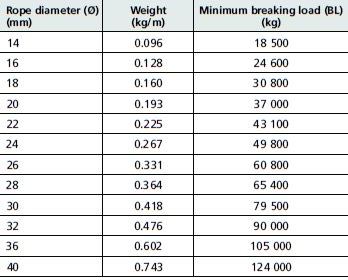
weight of knotted nets is greater than that of knotless nets.
Knotless netting has now almost completely replaced knotted net use in cage aquaculture. Knotless nets can be up to 50 percent lighter, their production costs are lower, they have a higher resistance to abrasion, are easier to handle and are stronger.
The main characteristics to consider regarding netting are the fibre material and characteristics, mesh size and shape, net braiding and colour.
Fibre polymer
As discussed above, a range of synthetic fibres can be used for netting. Different
materials vary in terms of durability, cost, maintenance and others characteristics. The most commonly used material is nylon (PA) with a braiding yarn of 210 denier. Denier is a technical textile term for nets, and it refers to the weight, in grams, of 9 000 metres of a single yarn.
Ultraviolet radiation causes polymer degradation (depolymerization) and a consequent long-term loss of strength. Nylon and the most common plastic fibres should always include UV stabilization by the addition of appropriate materials during the fibre production process.
Twine number and breaking load
Twine number is used to indicate the size of the net twine. It is composed of the "denier" number and the "ply", i.e. the number of strands braided together in each yarn.
A common standard is widely accepted for the knotted net identification, but in knotless netting, each producer usually has its own twine code. To make it more comprehensible, netting producers adopted a common terminology as is used in knotted net (for example, 210/96), but this does not mean that the weight (kilograms per square metre) or the breaking load is similar.
Nylon 210/72 represents a net made with 72 nylon yarns, each of 210 denier. This net will be stronger that a 210/60 net that is made with 60 yarns of the same denier. The most accurate method to evaluate the strength of a knotless net is the breaking load of the twine. This parameter, requested along with the net order and certified by the net supplier, can be easily verified with a net strength gauge, which is comprised of a hoist with a dynamometer (Note: breaking load measurement procedures are outlined in the ISO 1806 standards).
The weight of a unit of netting of standard surface area (usually 1 m2) is another parameter that can indicate the quality of the net a lighter net, with the same mesh size and the same breaking point, will be of better nylon quality. The weight per surface area unit can be easily measured in the field.
Therefore, by combining weight per square metre and breaking load (BL), one has a ratio of these two values, which can be used as an objective metric for comparison of nets (with the same mesh size and twine number) provided by different suppliers. The tables in Appendix 2 show the different weights and breaking loads of different nets. Weight is listed as weight per 1 000 meshes width x 1 m long. In order to find the weight per square metre:
Weight in kg/m2 = (weight per 1 000 meshes width ? 1 m long)/(half mesh size)
Ultraviolet degradation
Fibres are subject to UV degradation, which results in a decrease in the breaking load of twine over time.
Table 25 shows residual breaking loads for nylon exposed to UV light.
TABLE 25
Residual strength in percentage of different nylon fibres exposed to UV- outdoor exposure
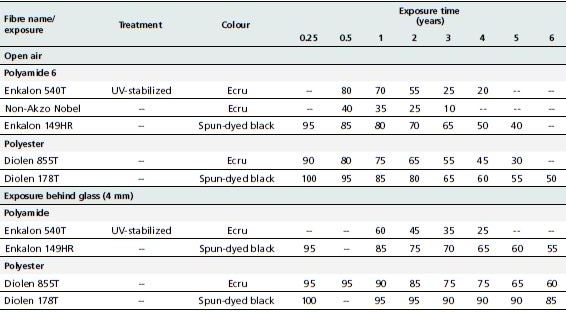
Source: Akzo Nobel Business Unit, 1995.
After net changing, regular checks with a net strength gauge should be conducted on each cleaned and repaired net before re-installation. Results should be recorded in a net register, and nets should be disposed of if yarns have a breaking load that does not meet acceptable standards. The acceptable residual strength of a net will depend on the site exposure. For example, used netting yarn with less than 60 per cent of the original strength for the jump net, and less than 65 per cent of the side net and base net, should be replaced.
Net coatings can affect the breaking load. Some antifouling coatings can increase the breaking load of the netting by up to 5-8 percent while most coatings can decrease the breaking load by up to 30 percent.
Mesh shape
Netting used for cage culture is available in two different mesh shapes, either square- shaped or hexagon-shaped. There are no apparent advantages in using one instead of the other; it is mainly a matter of traditional preferences. In Italy, for example, square mesh is preferred, while in Greece, hexagonal mesh is more widely used.
The following considerations are based on general experience, and should not be considered as facts or recommendations:
Square mesh advantages:
- mesh shape remains always open in strong currents, allowing the water to readily pass across the mesh;
- better durability in the water because the vertical loads are distributed throughout the aligned net twines;
easier to repair.
Square mesh - disadvantages:
more waste in the manufacturing process of the cage net because netting needs to be cut to make square panels;
- less elasticity to the vertical movement from wave action.
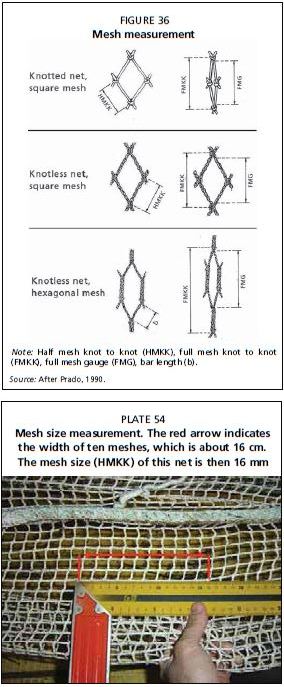
Hexagonal mesh - advantages:
more elasticity in vertical movement as cages are subject to wave action (this is a very useful characteristic for netting with low elastic power, such as HPPE);
- less waste during the manufacturing process. Hexagonal mesh- disadvantages:
more difficult to repair.
- not easy to measure the mesh size.
There is no overall preference, and the advantages and disadvantages of these meshes and their characteristics are continuously debated among farmers.
Mesh size
In the fishing industry, mesh size is the distance between two opposite knots of a stretched mesh, commonly expressed in millimetres. This can be measured as full mesh knot to knot (FMKK), which includes the twine of the netting, while full mesh gauge (FMG) represents the internal length of a stretched mesh, without including the knots.
In Mediterranean cage aquaculture, the mesh size (for square mesh netting) refers to the half distance between the knots when the mesh is stretched tight (or HMKK Figure 36). For hexagonal mesh, either the length of the bar or, better, the FMG is used to indicate the mesh size.
A quick mesh measurement can be obtained by measuring ten square meshes in a row, and dividing their total length by ten, essentially taking an average. This method would include the thickness of twine and therefore be an FMKK-type measurement (Plate 54).
The size of hexagonal mesh netting refers to FMG; thus, to avoid confusion, the type of mesh (i.e. square or hexagonal) must always be specified, along with the mesh size.
When choosing mesh size, it is essential to consider the size and shape of the fish. Cage nets will need to have a smaller mesh size for fingerlings and juveniles, while the mesh size can then increase with subsequent net changes as the fish grow. The larger the fish, the larger the mesh size should be. Although large fish can be accommodated in small mesh nets, this is not a good practice as the mesh size should be as large as possible so to allow the best water flow inside the cage net. For each farmed species, a relationship is determined between the mean weight of fish and the minimum mesh size needed. Net mesh sizes suitable for farming the European seabass (Dicentrarchus labrax) and gilthead seabream (Sparus aurata) are shown in Table 26.
TABLE 26
Fish size/mesh size (square-shaped mesh) relationship for the European sea bass and gilthead
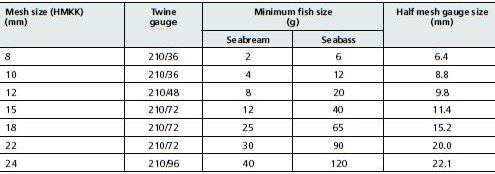
Size distribution in any fish cohort must also be considered. If there is a wide variation in size, the smaller fish may escape from the new net.
When choosing a mesh size, the shape and the morphological characteristics of the cultured fish species must also be taken into account. In some species, the mouth shape and mandible features (especially for fish with mouth invagination) may cause the fish to become trapped and, therefore, a conservative size of the mesh should be chosen.
Net braiding
The braiding property is a netting characteristic defined by the number of braidings performed by a netting machine on the yarn. It is usually referred to as soft, medium or hard, as the braiding level has an effect on the "softness" of a net. Given the same twine. number, a harder braiding will be stronger and have a higher breaking load. However, a net made with very hard braiding may be damaged if cleaned in a washing machine because the twine may become curly and the mesh shape may shrink. Softer braided nets can also suffer shrinkage problems, but will not be subject to curling.
Colour
Nylon nets are usually white. However, different colours can be useful if the cultured species shows biting behaviours. For example, gilthead seabream held in white cages will bite and abrade the net. These abraded points serve as a further attraction to the fish, which will persistently bite the same white spots, and quickly turn them into holes. In this case, a black coloured net is recommended. With a black-coloured net, the attractiveness of these abraded spots is reduced, and therefore the occurrence of holes is less common.
When ordering a net, all of the characteristics of netting listed above must be specified and verified on delivery. Table 27 provides an example of netting specifications.
TABLE 27
Example of netting specifications
